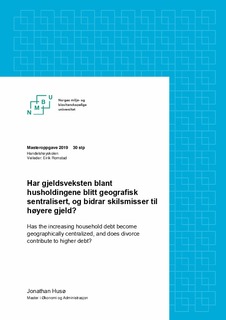| dc.contributor.advisor | Romstad, Eirik | |
| dc.contributor.author | Husø, Jonathan | |
| dc.coverage.spatial | Norway | nb_NO |
| dc.date.accessioned | 2019-10-16T09:22:53Z | |
| dc.date.available | 2019-10-16T09:22:53Z | |
| dc.date.issued | 2019 | |
| dc.identifier.uri | http://hdl.handle.net/11250/2622481 | |
| dc.description.abstract | Denne masteroppgaven tar for seg den norske husholdningsgjelden, og ser nærmere på sammenhengen mellom husholdningsgjeld og hvor sentralt man bor. Boligpriser har i nyere tid økt kraftig i byer enn det de har i resten av landet. Ettersom boligpriser og husholdningsgjeld har en tett sammenheng, så kan også husholdningsgjelden være betraktelig høyere i byer og sentrale strøk, noe som kan gjøre disse husholdningene mer sårbare for renteoppgang og inntektstap enn resten av landet. I tillegg inkluderer oppgaven en gruppe husholdninger som blir berørt av skilsmisser. Studier tilsier at i gode økonomiske tider, så skiller vi oss lettere og oftere. Denne gruppen husholdninger kan ha økt sårbarhet dersom disse gode økonomiske tider skulle snu seg. Studien tar utgangspunkt i gjeldsutviklingen på kommunenivå, og er avgrenset til Østlandet i Norge. Tidsperioden er satt til å gjelde fra 2009 til 2016, som er sett på som en god økonomisk periode.
Masteroppgaven har søkt å besvare og belyse følgende problemstilling og underhypoteser:
Finnes det noen sammenheng mellom gjeld hos husholdningene og hvor sentralt man bor? Og bidrar skilsmisser til økt gjeld?
Hypotese 1: Har husholdninger i sentrale strøk høyere gjeld enn de i utkantstrøk?
Hypotese 2: Fører skilsmisser til økt husholdningsgjeld i samfunnet?
Studien tar utgangspunkt i tilgjengelig data fra Statistisk Sentralbyrå (SSB) blant husholdninger på kommunenivå. For å besvare underhypotesene benyttes økonometrisk modellering for paneldata. Hvor forklaringsvariabler som inntekt, alder, og arbeidsledighet, sammen med sentrumsperiferi variabelen innbyggere per km2 og antallet skilsmisser, skal prøve å forklare gjennomsnittlig husholdningsgjeld blant kommunene. Ved bruk av FGLS metode, og PCSE estimatorer, finner jeg signifikant at husholdninger i sentrale strøk har mer gjeld enn de i utkantstrøk når alle andre forklaringsvariabler er kontrollert for. Jeg finner også signifikant at gjennomsnittlig husholdningsgjeld øker for hvert antall skilsmisse i kommunene. | nb_NO |
| dc.description.abstract | This master’s thesis explores the relationship of Norwegian household debt in clustered and central areas compared to peripheral areas. Recently, the house prices in Norway has increased to new heights in cities compared to the rest of the country. Since house prices and household debt has a close relationship, we should expect the same development for household debt. This makes households in cities and central areas more vulnerable to shocks that would result in higher interest rates, or loss of income due to higher unemployment rates. The thesis also includes another vulnerable group of households, those who divorce, who especially is vulnerable to loss of income. Studies has found a relationship between divorce and the state of the business cycle, which says that business cycles and divorce are pro-cyclical. Meaning that in good times there are more divorces. This thesis are looking at household debt in counties at the east side of Norway. The period is between 2009 and 2016, which is generally a good economic period in Norway.
This thesis aims to answer the following research question and its hypothesis:
Is there any relationship between household debt and how clustered you live? In addition, does divorce contribute to higher household debt?
Hypothesis 1: Household debt is higher in central areas compared to peripheral areas.
Hypothesis 2: Household debt increases with divorce.
The study is based on available data from statistics of Norway (SSB) at county level. Econometric modelling, using panel data, is used to answer the research question and its hypothesis. Where the independent variables like income, age, and unemployment together with the variables inhabitants per km2 and the number of divorcement is trying to explain the dependent variable average household debt. With the use of FGLS method, and PCSE estimators, I find significantly that central areas, like cities or clustered areas, has higher debt levels than peripheral areas when all other variables are controlled for. I also find that each divorce is significantly increasing the average household debt in the counties. | nb_NO |
| dc.language.iso | nob | nb_NO |
| dc.publisher | Norwegian University of Life Sciences, Ås | nb_NO |
| dc.rights | Attribution-NonCommercial-NoDerivatives 4.0 Internasjonal | * |
| dc.rights | Attribution-NonCommercial-NoDerivatives 4.0 Internasjonal | * |
| dc.rights.uri | http://creativecommons.org/licenses/by-nc-nd/4.0/deed.no | * |
| dc.title | Har gjeldsveksten blant husholdingene blitt geografisk sentralisert, og bidrar skilsmisser til høyere gjeld? | nb_NO |
| dc.title.alternative | Has the increasing household debt become geographically centralized, and does divorce contribute to higher debt? | nb_NO |
| dc.type | Master thesis | nb_NO |
| dc.source.pagenumber | 66 | nb_NO |
| dc.description.localcode | M-ØA | nb_NO |

